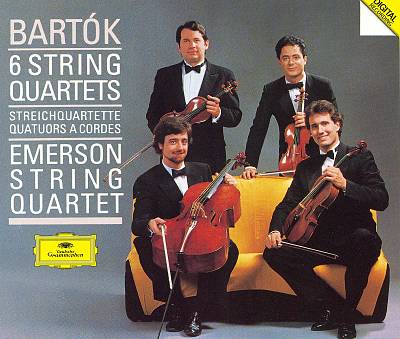Bartók Complete String Quartets
View record and artist detailsRecord and Artist Details
Composer or Director: Béla Bartók
Genre:
Chamber
Label: DG
Magazine Review Date: 12/1988
Media Format: CD or Download
Media Runtime: 149
Mastering:
DDD
Catalogue Number: 423 657-2GH2

Tracks:
| Composition | Artist Credit |
|---|---|
| String Quartet No. 1 |
Béla Bartók, Composer
Béla Bartók, Composer Emerson Qt |
| String Quartet No. 2 |
Béla Bartók, Composer
Béla Bartók, Composer Emerson Qt |
| String Quartet No. 3 |
Béla Bartók, Composer
Béla Bartók, Composer Emerson Qt |
| String Quartet No. 4 |
Béla Bartók, Composer
Béla Bartók, Composer Emerson Qt |
| String Quartet No. 5 |
Béla Bartók, Composer
Béla Bartók, Composer Emerson Qt |
| String Quartet No. 6 |
Béla Bartók, Composer
Béla Bartók, Composer Emerson Qt |
Author: David Fanning
A new cycle of quartets Bartok quartets has to be pretty special if it is to stand out in such select company as the above. The Emerson Quartet's is, and it does. Their nearest counterparts are the Alban Berg on EMI, in that both ensembles are powerful and refined, pay close attention to the letter of the score, and excel in virtuoso teamwork. The differences are that the Emerson are better recorded, are accommodated on two CDs (the Berg are on three), do not suffer from embarrassing mis-readings, show more imagination in countless details and, perhaps surprisingly, outshine their rivals on their 'home territory', namely the virtuosic 'middle' quartets.
The impression one gains from these recordings (I have not seen the Quartet in the concert hall) is of massive tonal projection and superlative clarity, each textural strand coloured and made audible to a degree possibly unrivalled in the recorded history of these works. DG's close brightly-lit, yet never oppressive recording quality must share some of the credit for that, of course. Combine this with controlled vehemence, headlong velocity and razor-sharp unanimity (any fast movement from quartets two to five can serve as illustration) and you have a formidable alliance of virtues.
At the other end of the scale, precision of sonority in a movement like the central night-music of No. 4 is no less remarkable, and attention to details of accent is scrupulous—for example, I wondered whether the first violin had fluffed a couple of 'snapped' pizzicatos in the following movement; in fact he differentiates between snaps with and without sforzando.
It may nevertheless be felt that this imaginative variety of sound is less conspicuous at low dynamic levels and in passages of more or less romantic expressiveness. Indeed, at the outset of No. 1 I suspected this would be as real a deficiency as it is with the Alban Berg—after all this work is supposed to be Bartok's 'funeral dirge' for his romance with Stefi Geyer, not a recreation of its passionate high-points. That suspicion is soon dispelled, however—as soon, in fact, as the viola's appassionato recitative on the third page. It returns, I have to say, in the outer movements of No. 6, where the sense of loss which surely lies behind the music is less fully registered than it might be. Again, others have found more inwardness in the opening of No. 3 and more mystery, astonishment even, in the slow movements of No. 5. Sul tasto 'one-hair-of-the-bow' huskiness may be something the Emerson could afford to deploy a little more daringly.
These reservations are not meant to deter anyone from buying a set which deserves to be hugely successful and which would be a worthy award winner. And I certainly don't want to imply that the performances are inexpressive; on the contrary, they are compellingly intense and passionate, and by no means indiscriminately so. But it would be a pity if the Emerson were to eclipse the rather different merits of the Vegh (Astree Auvidis/Pinnacle) who may not command such a kaleidoscopic range of colour but who conjour up more interesting shadows and probe into more mysterious, intimate corners (the Takacs on Hungaroton/Conifer take a broadly similar approach, without reaching quite the same level of artistry). Presumably DG's commitment to the Emerson means we will have to wait that much longer for the return of the classic Hungarian Quartet recordings to the catalogue, and the famous earlier mono Vegh set on Columbia is no less worthy of reinstatement. But for the moment it is a pleasure to welcome the appearance of what must be one of the most exciting chamber music recordings of recent years.'
Explore the world’s largest classical music catalogue on Apple Music Classical.
Included with an Apple Music subscription. Download now.

Gramophone Digital Club
- Digital Edition
- Digital Archive
- Reviews Database
- Events & Offers
From £9.20 / month
Subscribe
Gramophone Club
- Print Edition
- Digital Edition
- Digital Archive
- Reviews Database
- Events & Offers
From £11.45 / month
Subscribe
If you are a library, university or other organisation that would be interested in an institutional subscription to Gramophone please click here for further information.






